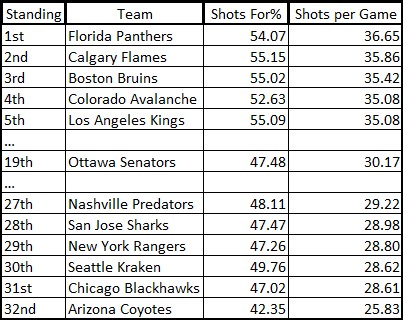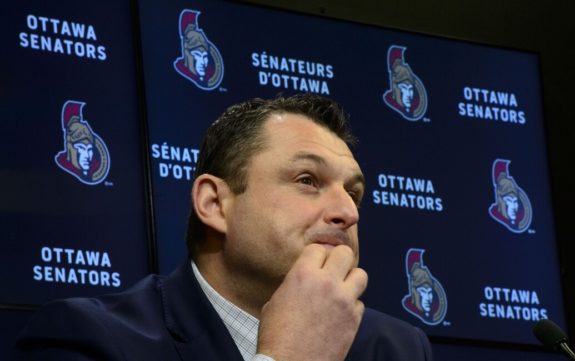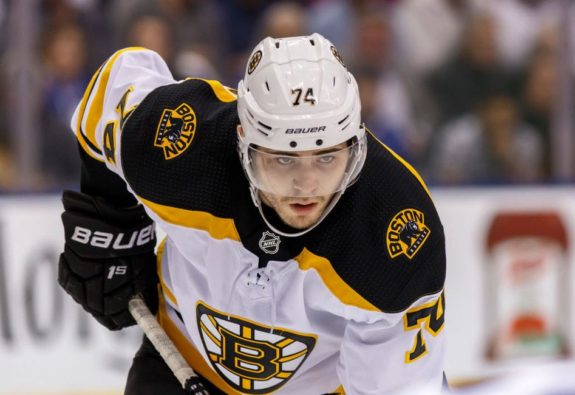The Ottawa Senators are not winning many games. While there are some glaring issues with their defence and goaltending, their problems extend beyond that. Looking at their shot production, the Senators should be scoring more. While the injury bug has been a factor, the real issue stems from the group central to the team’s rebuild. The game against the Arizona Coyotes on March 14, 2022, really highlighted this. They controlled play and limited shots against (in a huge manner) but they came away with a loss despite a shot differential of over 20.
So, what is the root cause of the lack of goal scoring? Step one is to see how they rank in a few key categories. Let’s keep it simple to start.

(Here’s a great primer on advanced stats used in this article)
Senators’ Ranking
The above table shows the top-five, bottom-five and the Senators’ relative shooting position this season. They sit just below the halfway point, averaging 30.17 per game. However, with the exception of the lowest shooting team (Arizona Coyotes), the spread between the bottom teams and the Sens is much lower than the spread between them and the top five teams.
Of course, the volume of shots doesn’t tell the whole story. Take, for instance, the Los Angeles Kings. They rank fifth in the league in shots per game, narrowly behind the Colorado Avalanche. With 841 high-danger chances for (HDCF) and only converting 100 of those (good for a rate of 11.9 percent), they rank first in the league for HDCF but 16th for high-danger goals for (HDGF) (their conversion percentage is ranked 30th).
With the Senators sitting at 19th in the league in shots per game, they have amassed 673 HDCF and just 83 HDGF. That puts them at 18th in chances and all the way down at 27th in goals. Their conversion rate of 12.3 percent places them 28th in that category.
Interpreting the Data
What does this really mean? The Avalanche are likely en route to the Presidents’ Trophy with a 0.746 points percentage and just 21 games left to play, but they rank 13th in HDCF. What really matters here is how these teams convert their chances. That’s where the Senators are struggling this season and amplifies their defensive issues and goaltending, but they’re not as bad as they seem. So, what is the root cause of their scoring issues? First, here’s a look at their chances, shots, and conversion rates for each of the high, medium, and low-danger opportunities.

For converting the high-danger chances, the Senators are below the league average in both goals/chance and goals/shot. Their chances and shots are slightly under the league average, but they are close. At medium danger, they again rank below the league average, and it’s the same for low-danger chances.
The Senators are near the league average in generating chances but decently below the league average in converting those opportunities. They can get the puck into position but struggle to capitalize on those opportunities. The question is, why? Are they not shooting enough on those chances? Are they choosing poorer shots when the opportunity arises? Is it simply a case of not having players who can finish the play?
While it’s true that they have room to continue building, their performance is below where it should be given their roster. Look at players like Tim Stutzle, Josh Norris, Drake Batherson (currently injured) – these are all skilled forwards who can bury the puck just as well as almost anyone in the league. So, how does the team fix this issue and improve on its conversion rate?
Senators’ Systems: Addressing the Scoring Issue with Coaching & Roster Moves
Coach DJ Smith’s Game Plan
One option is to adjust the game plan. I don’t pretend to know what is going on in DJ Smith’s head, but it’s not outside the realm of possibility that coaching is an issue here. If I were in his shoes, I’d be looking at the options the team is running in the offensive zone once they set up. The Sens are built for speed and transitional play through the neutral zone. Game footage highlights that this style works well for them. Strong neutral zone play from the forward group and solid outlet passes by Tomas Chabot and Artem Zub help propel the team back to the offensive zone. However, for a skilled puck-mover and reasonably strong skater, Chabot doesn’t attempt to rush frequently. Perhaps there’s an opportunity to have him more involved in the play to try and set up in the offensive zone.

The Senators’ forecheck is undoubtedly strong whenever Brady Tkachuk is on the ice. However, it’s a bit of a struggle to get the cycle working effectively once they get the puck. Changing how players are spacing out in the offensive zone, or stressing different passing routes could help secure either additional chances or more prime shooting opportunities from those high-danger chances. We recently saw the Coyotes’ Lawson Crouse score a great shorthanded goal by breaking up a pass back to Chabot at the point. From there, he was gone with speed. If I’m coaching, I’d be looking for what the other options were available before sending the puck back through a lane that appears open but is readily contested.
Changing Deployment
Another option is to re-think the usage of the roster. Of course, in a season that’s been mired by injuries, we don’t want to look too deeply as a roster issue. Stutzle’s career average shooting rate is 10.57 percent. This season he is slightly below that. Line mixes have been happening rather frequently as the Senators continue to deal with injuries and go through call-ups and drops to see what fits.
However, what stands out among these changes is that the best on-ice shooting percentage for a line on the team comes when Stutzle is matched up with the bottom D-pair. In fact, 66 percent of Josh Brown’s assists at even strength this season have come when he’s on the ice with Stutzle. In just over 229 minutes of 5-on-5 ice time with Nick Holden, Stutzle has a 17.39 percent shooting rate. If I’m in the front office, I’m examining the line matchups and deployment to see where adjustments can be made to facilitate this success.
Adding to the Senators Roster – Players Who Theoretically Could Help
The other option is to look at acquiring pieces that can help elevate the scoring threat. With over $10 million available in cap space and no major free agent issues coming up, the Senators have room to maneuver either at the trade deadline or in free agency. They have had success at drafting and have ten picks in the upcoming draft. As most signs point to it being a weaker than average class, now might be a good time to throw picks out to snap up players with a little bit of term.
Someone like Jake DeBrusk could be a good fit. As the relationship between DeBrusk and the Boston Bruins recently soured, there could be a deal to be made with picks and/or a prospect. The Bruins re-signed DeBrusk to a two-year deal on deadline day, but DeBrusk has not pulled his trade request, thus leaving the door open for a possible sign-and-trade situation before the closing of the trade deadline.

DeBrusk’s run-and-gun style would be a nice complement to the Senators’ roster, working to generate chances off the rush and alleviate some of that scoring pressure from the rest of the top six. Tkachuk is a lot more dangerous in front of the net when there are legitimate shooting threats on the ice with him.
Another great fit into the Senators’ system is unfortunately a terrible fit for a Canadian team. The skillset and game of Tyler Bertuzzi would slot right into their game plan. A player willing to forecheck hard has good speed and has seen solid production when playing alongside skill-based players like Lucas Raymond, he is a natural fit to add a bit of sandpaper and provide a scoring threat alongside Stutzle. To the chagrin of all Canadian teams, this is nigh impossible unless he makes a sudden about-face on his vaccination stance or the Canadian government changes the current protocol.
If we look to free agency, there are a number of options available, but not many available to the Senators. Unfortunately, they are not a desirable market. Albeit a beautiful city, the team has a history of failing to commit to players in a serious manner, and as a small-market team, they often lack the ability to lure players away from other cities. There is always the chance that they might be able to make some offers to players heading into the back nine of their career, though. Another year or two to get Stutzle, Drake Batherson, and Shane Pinto more adjusted to the league and re-evaluating to see if coaching really is an issue would help get the Sens closer to scoring, and more importantly, closer to making the playoffs.